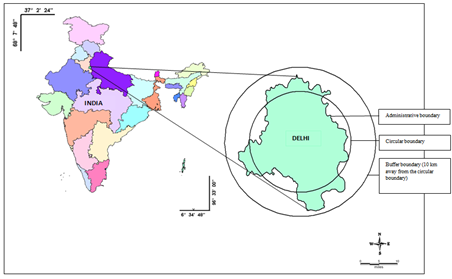Study Area
Delhi is one of the largest metropolis by area and second largest
metropolis by population. It is the eighth largest metropolis in the
world by population with more than 16.75 million inhabitants in
the territory and with nearly 22.2 million residents in the national
capital urban region. Delhi is located at 28.61 North latitude and
77.23 east longitude. It borders the Indian states of Uttar Pradesh
to the east and Haryana on the north, Rajasthan on the west and
south. Delhi is situated on the banks of the River Yamuna. The River
Yamuna serves as the bed of agricultural land (Veronique Dupont,
Figure 1: Location and spatial extent of Delhi

Fig. 2. Growth of population (in number crores) of Delhi from 1901 to 2011.
|
Area
(sq. kms.) |
Year |
Population (lakhs) |
Population Density
(Persons per sq.km.) |
Delhi |
2926.03 |
1971 |
4065698 |
1207 |
1981 |
6220406 |
1899 |
1991 |
9420644 |
2804 |
2001 |
13850507 |
4371 |
2011 |
16753235 |
5726 |
Table1: Area, Population and Population density of Delhi (Source: Census India-1971, 1981, 1991, 2001 and 2011).
2004). Delhi lies about 300 m above the sea level. Fig. 1 depicts the
Delhi administrative boundary (with circular boundary) and 10 km
buffer considered. The buffer region is expected to reveal the
sprawl trend which helps in visualizing the likely urban growth in
the region. The National Capital Territory (NCT) of Delhi is spread
over an area of 1484 sq km and the Delhi metropolitan area lies
within NCT. The NCT has three local municipal corporations:
Municipal Corporation of Delhi (MCD), New Delhi Municipal
Council (NDMC) and Delhi Cantonment Board (Debnath and
Eugene, 2004). The central Delhi is considered as central business
district and consists of many industrial and residential areas and
Delhi Fort and Jumma masjid are famous monuments found in
Central Delhi. The Rastrapathi Bhavan, Parliament House and Supreme
Court of India etc. are also located in New Delhi.
Fig. 2 and Table 1 portray the population growth of Delhi during
1901e2011. Table 1 reveals that the population density has
increased from 1207 (1970) to 5726 (2011) persons per sq.km. The
FDI inflows to Delhi during the period 2000e2006 were found to be
Rs.318.61 billion. The total FDI inflows into Delhi is about US$ 20.1
billion according to Economic survey of India. The intensify growth
of economy and higher per capita income within the urban district
have influenced the real estate’s business resulting hike in the costs
of land and cost of living..
2. Data used (Table 2)
DATA |
Year |
Purpose |
Landsat Series Multispectral sensor(57.5m) |
1973 |
Land cover and Land use analysis |
Landsat Series Thematic mapper (28.5m) and Enhanced Thematic Mapper sensors |
1980,1998, 2010 |
Land cover and Land use analysis |
Survey of India (SOI) toposheets of 1:50000 and 1:250000 scales |
|
To Generate boundary and Base layer maps. |
Field visit data –captured using GPS |
|
For geo-correcting and generating validation dataset |
Table 2: Temporal spatial data used in the Analysis
Citation : T.V. Ramachandra, Bharath H. Aithal and M.V. Sowmyashree, 2015. Monitoring urbanization and its implications in a mega city from space: Spatiotemporal patterns and its indicators, Journal of Environmental Management, 148 (2015):67-81, http://dx.doi.org/10.1016/j.jenvman.2014.02.015.
Corresponding author:
|
| |
Dr. T.V. Ramachandra
Energy & Wetlands Research Group, CES TE 15
Centre for Ecological Sciences
New Bioscience Building, Third Floor, E –Wing
[Near D-Gate], Indian Institute of Science,
Bangalore – 560 012, INDIA.
|
Tel : +91-80-2293 3099/2293 3503 - extn 107
Fax : 91-80-23601428 / 23600085 / 23600683 [CES-TVR]
E-mail : cestvr@ces.iisc.ac.in, energy@ces.iisc.ac.in,
Web : http://wgbis.ces.iisc.ac.in/energy |
|



